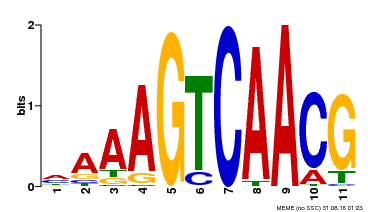- Eulgem T,Rushton PJ,Robatzek S,Somssich IE
The WRKY superfamily of plant transcription factors.
Trends Plant Sci., 2000. 5(5): p. 199-206
[PMID:10785665] - Riechmann JL, et al.
Arabidopsis transcription factors: genome-wide comparative analysis among eukaryotes.
Science, 2000. 290(5499): p. 2105-10
[PMID:11118137] - Yamada K, et al.
Empirical analysis of transcriptional activity in the Arabidopsis genome.
Science, 2003. 302(5646): p. 842-6
[PMID:14593172] - Zhu J, et al.
An Arabidopsis homeodomain transcription factor gene, HOS9, mediates cold tolerance through a CBF-independent pathway.
Proc. Natl. Acad. Sci. U.S.A., 2004. 101(26): p. 9873-8
[PMID:15205481] - Guan Y,Nothnagel EA
Binding of arabinogalactan proteins by Yariv phenylglycoside triggers wound-like responses in Arabidopsis cell cultures.
Plant Physiol., 2004. 135(3): p. 1346-66
[PMID:15235117] - Hass C, et al.
The response regulator 2 mediates ethylene signalling and hormone signal integration in Arabidopsis.
EMBO J., 2004. 23(16): p. 3290-302
[PMID:15282545] - Chang S,Pikaard CS
Transcript profiling in Arabidopsis reveals complex responses to global inhibition of DNA methylation and histone deacetylation.
J. Biol. Chem., 2005. 280(1): p. 796-804
[PMID:15516340] - Koroleva OA,Tomlinson ML,Leader D,Shaw P,Doonan JH
High-throughput protein localization in Arabidopsis using Agrobacterium-mediated transient expression of GFP-ORF fusions.
Plant J., 2005. 41(1): p. 162-74
[PMID:15610358] - Lee BH,Henderson DA,Zhu JK
The Arabidopsis cold-responsive transcriptome and its regulation by ICE1.
Plant Cell, 2005. 17(11): p. 3155-75
[PMID:16214899] - Suzuki N, et al.
Enhanced tolerance to environmental stress in transgenic plants expressing the transcriptional coactivator multiprotein bridging factor 1c.
Plant Physiol., 2005. 139(3): p. 1313-22
[PMID:16244138] - Taki N, et al.
12-oxo-phytodienoic acid triggers expression of a distinct set of genes and plays a role in wound-induced gene expression in Arabidopsis.
Plant Physiol., 2005. 139(3): p. 1268-83
[PMID:16258017] - Stein M, et al.
Arabidopsis PEN3/PDR8, an ATP binding cassette transporter, contributes to nonhost resistance to inappropriate pathogens that enter by direct penetration.
Plant Cell, 2006. 18(3): p. 731-46
[PMID:16473969] - Truman W,de Zabala MT,Grant M
Type III effectors orchestrate a complex interplay between transcriptional networks to modify basal defence responses during pathogenesis and resistance.
Plant J., 2006. 46(1): p. 14-33
[PMID:16553893] - He P, et al.
Specific bacterial suppressors of MAMP signaling upstream of MAPKKK in Arabidopsis innate immunity.
Cell, 2006. 125(3): p. 563-75
[PMID:16678099] - Mosher RA,Durrant WE,Wang D,Song J,Dong X
A comprehensive structure-function analysis of Arabidopsis SNI1 defines essential regions and transcriptional repressor activity.
Plant Cell, 2006. 18(7): p. 1750-65
[PMID:16766691] - Tosti N, et al.
Gene expression profiles of O3-treated Arabidopsis plants.
Plant Cell Environ., 2006. 29(9): p. 1686-702
[PMID:16913859] - Lee DJ, et al.
Genome-wide expression profiling of ARABIDOPSIS RESPONSE REGULATOR 7(ARR7) overexpression in cytokinin response.
Mol. Genet. Genomics, 2007. 277(2): p. 115-37
[PMID:17061125] - Qutob D, et al.
Phytotoxicity and innate immune responses induced by Nep1-like proteins.
Plant Cell, 2006. 18(12): p. 3721-44
[PMID:17194768] - Lee KP,Kim C,Landgraf F,Apel K
EXECUTER1- and EXECUTER2-dependent transfer of stress-related signals from the plastid to the nucleus of Arabidopsis thaliana.
Proc. Natl. Acad. Sci. U.S.A., 2007. 104(24): p. 10270-5
[PMID:17540731] - Libault M,Wan J,Czechowski T,Udvardi M,Stacey G
Identification of 118 Arabidopsis transcription factor and 30 ubiquitin-ligase genes responding to chitin, a plant-defense elicitor.
Mol. Plant Microbe Interact., 2007. 20(8): p. 900-11
[PMID:17722694] - Chawade A,Br
Putative cold acclimation pathways in Arabidopsis thaliana identified by a combined analysis of mRNA co-expression patterns, promoter motifs and transcription factors.
BMC Genomics, 2007. 8: p. 304
[PMID:17764576] - Ascencio-Ib
Global analysis of Arabidopsis gene expression uncovers a complex array of changes impacting pathogen response and cell cycle during geminivirus infection.
Plant Physiol., 2008. 148(1): p. 436-54
[PMID:18650403] - van Verk MC,Bol JF,Linthorst HJ
WRKY transcription factors involved in activation of SA biosynthesis genes.
BMC Plant Biol., 2011. 11: p. 89
[PMID:21595875] - Gaudinier A, et al.
Enhanced Y1H assays for Arabidopsis.
Nat. Methods, 2011. 8(12): p. 1053-5
[PMID:22037706] - Moreau M, et al.
EDS1 contributes to nonhost resistance of Arabidopsis thaliana against Erwinia amylovora.
Mol. Plant Microbe Interact., 2012. 25(3): p. 421-30
[PMID:22316300] - Hu Y,Dong Q,Yu D
Arabidopsis WRKY46 coordinates with WRKY70 and WRKY53 in basal resistance against pathogen Pseudomonas syringae.
Plant Sci., 2012. 185-186: p. 288-97
[PMID:22325892] - Renault H, et al.
γ-Aminobutyric acid transaminase deficiency impairs central carbon metabolism and leads to cell wall defects during salt stress in Arabidopsis roots.
Plant Cell Environ., 2013. 36(5): p. 1009-18
[PMID:23148892] - Efroni I, et al.
Regulation of leaf maturation by chromatin-mediated modulation of cytokinin responses.
Dev. Cell, 2013. 24(4): p. 438-45
[PMID:23449474] - Ding ZJ,Yan JY,Xu XY,Li GX,Zheng SJ
WRKY46 functions as a transcriptional repressor of ALMT1, regulating aluminum-induced malate secretion in Arabidopsis.
Plant J., 2013. 76(5): p. 825-35
[PMID:24118304] - Ding Y, et al.
Four distinct types of dehydration stress memory genes in Arabidopsis thaliana.
BMC Plant Biol., 2013. 13: p. 229
[PMID:24377444] - Ding ZJ, et al.
Transcription factor WRKY46 regulates osmotic stress responses and stomatal movement independently in Arabidopsis.
Plant J., 2014. 79(1): p. 13-27
[PMID:24773321] - Ding ZJ, et al.
Transcription factor WRKY46 modulates the development of Arabidopsis lateral roots in osmotic/salt stress conditions via regulation of ABA signaling and auxin homeostasis.
Plant J., 2015. 84(1): p. 56-69
[PMID:26252246] - Sheikh AH, et al.
Regulation of WRKY46 Transcription Factor Function by Mitogen-Activated Protein Kinases in Arabidopsis thaliana.
Front Plant Sci, 2016. 7: p. 61
[PMID:26870073] - Yan JY, et al.
A WRKY Transcription Factor Regulates Fe Translocation under Fe Deficiency.
Plant Physiol., 2016. 171(3): p. 2017-27
[PMID:27208259] - Chen J, et al.
Arabidopsis WRKY46, WRKY54, and WRKY70 Transcription Factors Are Involved in Brassinosteroid-Regulated Plant Growth and Drought Responses.
Plant Cell, 2017. 29(6): p. 1425-1439
[PMID:28576847] - Ma J, et al.
Overexpression of TaWRKY146 Increases Drought Tolerance through Inducing Stomatal Closure in Arabidopsis thaliana.
Front Plant Sci, 2017. 8: p. 2036
[PMID:29225611]
|





